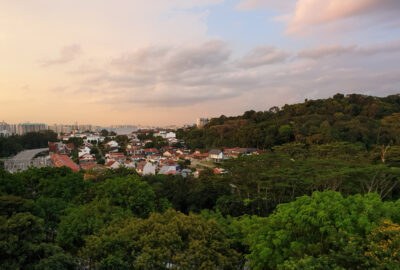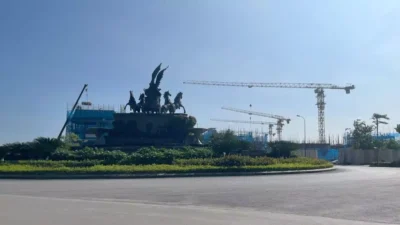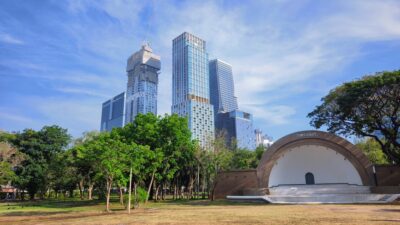Interview with the tycoon: the Philippines’ Andrew Tan on his mega world
The tumultuous ’90s saw the developer turn an old textile mill complex into the country’s most coveted corporate address. Today, the seasoned Filipino-Chinese entrepreneur continues to change the game

Megaworld Corporation, the pioneering mixed-use property developer founded by Filipino-Chinese tycoon Andrew Tan, has thus far created 23 townships and integrated developments in the Philippines. And the tycoon is just warming up.
Tan, whose wide-ranging business interests—from hotels and resorts, to fast food and liquor—are all gathered under holdings company Alliance Global, attributes the lion’s share of his success to his game-changing real estate enterprise, Megaworld Corporation.
As chairman and founder of Megaworld, Tan pioneered mixed-used development in Metro Manila in the 1990s, changing the industry’s landscape and driving the property sector into a rush to build similar all-inclusive townships across the metropolis. Its flagship Eastwood City—a 17-hectare enclave of sleek office towers, modern residential buildings, and commercial structures within Quezon City—bears the DNA of his company’s innovative live-work-play-learn concept, a masterplan that incorporates work spaces with residential and recreational facilities.
Eastwood, a former textile mills complex, became the country’s most coveted corporate address when it opened in 1997, providing a springboard for what was then a nascent BPO industry that now employs a million Filipinos and whose total income is projected to hit USD40 billion by 2020.
Such innovation in property development was designed to, among other things, cut home-to-office travel time and increase quality of life in an otherwise dense urban sprawl whose productivity has been hobbled by traffic woes.
The people-centred concept proved nothing short of revolutionary—Megaworld has since launched similar townships all over Metro Manila, effectively reconfiguring the Philippine capital to include self-contained pockets of hyper-productivity and sustainable urban living.
Sitting comfortably on a Forbes-estimated fortune of USD2.4 billion, Tan’s success is driven primarily by humble beginnings. The son of poor immigrants from Fujian province in South China, Tan was 16 when his family moved to the Philippines. As a newcomer in the country, his father told him he had to strive harder than most, instilling in him the importance of hard work and diligence—values that guided him through his first job as a marketing executive and, when he eventually established Megaworld in 1989, the company’s challenge-riddled nascent years.
Two weeks after launching his first Megaworld project, army forces loyal to the Marcos dictatorship staged the most serious coup d’état against Philippine President Corazon Aquino. The decision to still pursue the project, he revealed in a local interview, was “one of the toughest” he had to make. This was further tested when the Asian financial crisis hit in 1997 and threatened the real estate industry—around the time Megaworld launched Eastwood City.
As history would attest, Tan’s gambit paid off. Today, Tan’s business empire has spread beyond the Philippine capital to other growth markets in the nation, having replicated the success of Mega world’s township developments in such provinces as Pampanga, located north of Manila and whose Clark International Airport is a growing hub for regional airlines, and in the cities of Cebu, Iloilo, Bacolod, and Davao.
In this interview, Tan shares how his groundbreaking concept has evolved to meet the future.
Looking back on Megaworld’s extensive experience in building mixed-use developments, how do the townships you are designing/building today compare with those of 10 years ago?
We are keeping up to the changing times—just this year, we launched iTownships, a campaign that is intended to guide us in future-proofing our townships. The campaign allows us to create “future-ready” communities by integrating innovative design, safety, smart technology, connectivity, and energy efficiency into our developments.

What trends have you pioneered or seen emerge in mixed-use design?
We’ve been known to be a builder of integrated urban townships that spur economic activities, generate employment, and provide walkability and convenience for everyone. These mixed-use developments allow consumers to put greater value on time.
Having pioneered the country’s first cyberpark, we’ve also taken the active role in growing the BPO industry in the Philippines. Since we built Eastwood City, the BPO industry in the country has grown exponentially which eventually generated millions of jobs for Filipinos.
Are you aware of a shift across Asia in the number of developers who now favor mixed-use over dedicated office blocks, retail projects, hotels, etc.? What do you think is driving that?
Time has become more and more limited for today’s consumers. People want to experience everything—shopping, dining, relaxation, entertainment and learning, among others—within the very community where they live and work.
BY INTRODUCING TOWNSHIPS LIKE UPTOWN BONIFACIO, WE ARE ABLE TO PROMOTE SYNERGIES AND MAXIMISE THE USE OF OUR LAND. THIS, IN TURN, LENDS GREATER VALUE TO OUR COMMUNITIES BECAUSE BOTH CONSUMERS AND BUSINESSES APPRECIATE BEING A PART OF DYNAMIC COMMUNITIES WHERE THEY CAN TRULY ENJOY THE LIVE-WORK-PLAY LIFESTYLE
We had foreseen this happening, even back in the late 90s, which is why we conceived of the idea of fully integrated townships. And today, we are proud to have created 23 townships and mixed-use developments across the Philippines, which have become models of real estate development in our country.
Does building a mixed-use project provide a “safety net”, allowing you to diversify the assets in a project and mitigate against the failure of any one usage?
Rather than looking at it as a safety net, we would like to treat it as an opportunity to grow our portfolio. In Uptown Bonifacio, for example, we just launched our fourth residential condominium development. It will rise just a few blocks away from Uptown Mall and Uptown Parade—two prime lifestyle destinations in Metro Manila. Within the vicinity, too, are some of the most prestigious international academic institutions, the headquarters of the industry-leading companies, and soon a mega transport hub.
Studies have shown that “where American site selection strategies are often based on adjacency to highways or other main roads, in Asia proximity to foot traffic and transportation hubs are the leading drivers of where shopping centres and mixed-use developments are built.” By introducing townships like Uptown Bonifacio, we are able to promote synergies and maximise the use of our land. This, in turn, lends greater value to our communities because both consumers and businesses appreciate being a part of dynamic communities where they can truly enjoy the live-work-play lifestyle.
Looking to the future of mixed-use developments, what’s the challenge for Megaworld?
We’ve been a leader in this category in the Philippines, and we see ourselves building more. The challenge now is how to continuously bring in innovations into our township developments. This is not only about employing technology, but also finding other suitable components that make the live-work-play concept more exciting.
This article originally appeared in Issue No. 151 of PropertyGuru Property Report Magazine
Recommended
Meet the expert helping overseas investors crack Australia’s property market
Ivan Lam of property advisors Charter Keck Cramer helps clients navigate Australia’s complex real estate dynamics
6 spots to check out in Singapore’s Bukit list neighbourhood
The sought-after Singapore neighbourhood offers lifestyle amenities, green space, and new residential projects
Thailand’s real estate sector watches closely as the Shinawatras return to power
Time will tell if the return to power in Thailand of the Shinawatras will lift the country’s ailing real estate sector
China’s homebuying surge: Can new stimulus measures keep the market rally alive?
Stimulus measures have sparked a surge in homebuying activity around China, but many are sceptical the shift will endure








